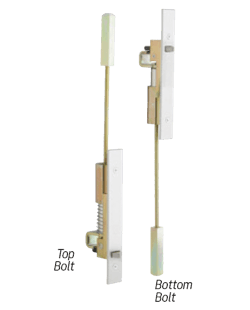How many times has this happened to one of your colleagues? When discussing a recent job replacing an old lock, you ask, "What else did you sell them?" Your locksmith friend, taken off guard, responds by telling you that he was only called in to fix a lock problem.
Let's pause here. Your friend just missed a golden opportunity to upsell. He could have captured more business by simply showing the customer how he could improve the door opening with some simple door hardware changes.
Think about it. Almost every door has additional hardware outside the typical lock, exit device and door closer. There are hinges, pivots, pulls, plates, flush bolts, coordinators, hooks and a variety of other door hardware accessories. You might as well be getting this business instead of someone else.
Besides creating more business, you display the ability to provide a complete door solution. In some cases, this might be an upgrade from your customer's current accessories. In other cases, it might be the addition of accessories that improve the functionality of a door opening. This would allow you to be the one vendor your customer comes to not only for installations and replacements but also products. It's a win-win for both you and your customer.
Things to Consider
The majority of doors have hinges but when was the last time you thought about using a pivot? They can be of great help in many situations. For example, you reduce the stress on the frame of a door by distributing the weight of the door throughout the floor and building structure. This makes a pivot the ideal solution for heavy doors. If you are in need of a more pleasing aesthetic option, you should consider a pocket pivot. It is not easily visible to the end user but still provides the advantages of a pivot.
Likewise, almost every commercial building will have doors that either utilize or need some type of pull or plate. Interestingly, there is a wide range of choices from a decorative pull to basic plates that help to protect the door from wear and tear.
Flush bolts keep a pair of double doors secure when there isn't an anchor to keep the doors from being pulled open. There are automatic flush bolts, constant flush bolts and manual flush bolts. With automatic flush bolts, when an inactive door is latched, the bolts are extended. The door is unlatched and the bolts retract when the active door is opened. With constant latching flush bolts, the inactive door remains latched until the active door is opened, releasing the automatic bottom bolt. Then, the top bolt can be manually released. The inactive door will relatch when closed. Manual flush bolts are simple. A double action spring provides automatic holding of the brass bolt in a projected or retracted position to assure ease of operation.
One of the simplest pieces of door hardware is the stop. Door stops come in a variety of styles, including floor stops and wall stops. It's rare to find a door in a commercial setting that does not need a door stop but they are frequently overlooked. Door stops can help avoid injury or wall damage by preventing a door from opening too far. Be sure to keep your eye out for openings without door stops or door stops in need of replacing.
Brian Marris is marketing manager, Ives, an Allegion brand company






